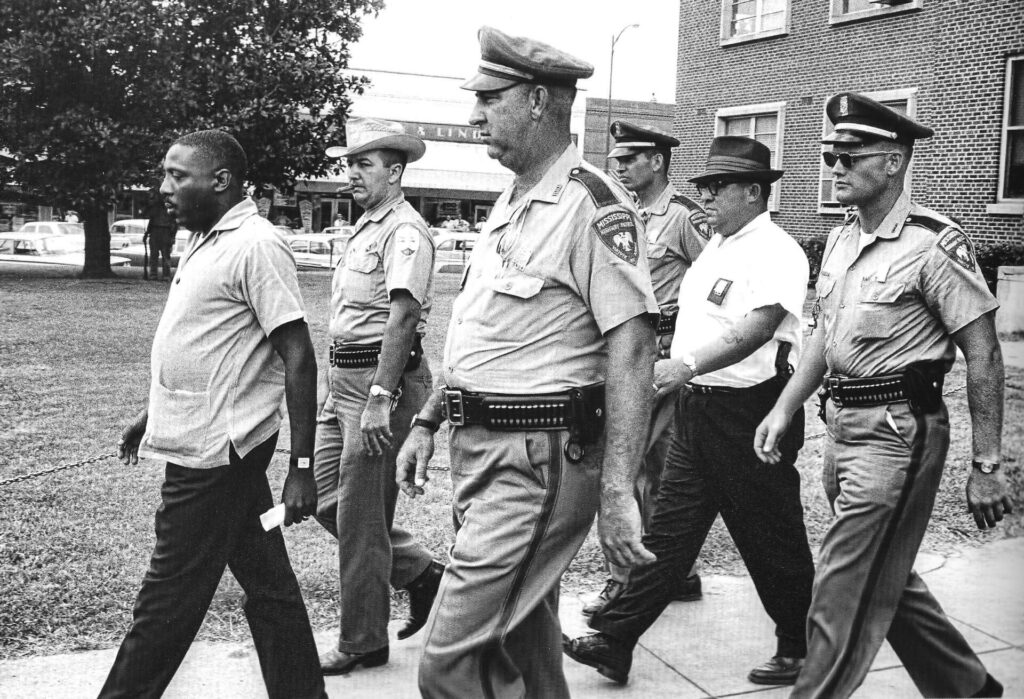“A Past That Won’t Rest: Images of the Mississippi Civil Rights Movement.” Photographs by Jim Lucas. Edited by Jane Hearn. University Press of Mississippi. 153 pages. $40.00.
Editor’s Note: Jane Hearn will hold a book signing for “A Past That Won’t Rest” at 5 p.m. Tuesday, August 14, 2018, in Off Square Books.

Fannie Lou Hamer sits at the witness table, waiting to testify for Senator Robert F. Kennedy. She is a large strong woman and her arms are folded; she is sick and tired of being sick and tired. She has the heavy commanding quiet of a volcano about to erupt.
Cecil Ray Price looks like a bigoted Southern lawman, down to the scowl, the jowls, and the gun-belt. In a moment of absolutely bitter irony, he helps carry gurneys bearing the bodies of Michael Schwerner, James Chaney, and Andrew Goodman. The photo is bitter and ironic because Price was the deputy sheriff who handed over Schwerner, Chaney and Goodman to the Neshoba County racist vigilantes who killed them.
A view from the Freedom School in Meridian says volumes about the loneliness of the civil rights worker. A dark upstairs room frames a window that looks out on the street. The window is open on a hot summer afternoon. Bumper stickers plastered on the window proclaim One Man One Vote. Cars line the street but the sidewalks are almost empty. Election Day will be a long way off. (The offices where this photo may have been taken, the Fielder & Brooks Drug Store Building, was the last place where anyone friendly to Schwerner, Chaney, and Goodman saw them alive.)
These photos were taken in the early 1960’s by Jim Lucas, a young Mississippi photographer who covered the civil rights movement. Collected in “A Past That Won’t Rest,” they open new windows on crucial moments from that era.
It is not only the history that makes these photos memorable. Many are framed and timed with great skill. In one, where mourners gather outside a church, the random dark-and-light scattering created by a crowd in somber clothing plays off the sheen of the hearse in the middle of the crowd. A snapshot catches an instant on a sidewalk, when an elderly man takes a pamphlet from a youth.

Among other lawmen, Neshoba County Deputy Sheriff Cecil Ray Price (with cigar) escorts activist Dick Gregory out of the Neshoba County courthouse, in June 1964. Photo by Jim Lucas.
In 1967, Lucas photographed Byron De La Beckwith on the steps of the Mississippi State Capitol. Beckwith’s face has half a smirk on it; he had twice beaten murder charges for killing Medgar Evers. Lucas caught the man from an angle that makes him seem one with the building. He stands there in the place of one of the columns that hold up the structure, part of the edifice of Jim Crow.
Charles Overby, who knew Lucas in the early Sixties when both worked for the Jackson Daily News, provides an introduction. Other historians add introductions that frame individual chapters. Howard Ball writes on Freedom Summer and the Neshoba County killings, Aram Goudsouzian on James Meredith’s “March Against Fear” in 1966, and Stanley Nelson on the Natchez bombing that killed Wharlest Jackson, the last black man killed by the “Silver Dollar” element of the Ku Klux Klan.
Ellen B. Meacham discusses Robert F. Kennedy’s fact-finding visit to the Delta in April 1968 (with Peter Edelman adding a personal recollection of that trip – during which he met his future wife, young activist NAACP lawyer Marian Wright). Robert E. Luckett writes of less well-known bombings and boycotts, like the blasts that tore holes in Jackson’s Beth Israel Synagogue and the home of Rabbi Perry Nusbaum.
Jim Lucas, a native of Jackson, started taking photographs for the Daily News when he was fourteen. He worked as a stringer for Time Magazine and the Associated Press; he took photographs of the Meredith march for Life Magazine. In 1968, he was drafted, and the Army sent him to Vietnam.
When Lucas returned to Mississippi, he moved into film photography. He worked on “Thieves Like Us” (1974), which Robert Altman filmed on location in Mississippi, and later had credits as a cameraman and cinematographer for a series of Westerns and modern Westerns (“Brubaker,” “The Long Riders,” “Honeysuckle Rose”). He did free-lance work for “Sixty Minutes” and shot award-winning commercials.

In October 1980, on location in Texas, aged only 36, Lucas died in an automobile accident. His widow, Jane Hearn, has edited this volume. Out of “a file cabinet full of negatives, contact sheets, prints, and memorabilia,” she writes, “I came to understand the treasures that were buried among the many images of high school and college life.” With this book, she has paid due honor to a talented man who recorded great events. The rest of Jim Lucas’ photos and papers can be found in the University of Mississippi Department of Archives and History. They should repay the effort of seeking them out.
Allen Boyer is the Book Editor of HottyToddy.com.

